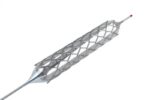P-selectin is an adhesion molecule involved in the interactions between endothelial cells, platelets and leukocytes. Inclacumab is a recombinant monoclonal antibody against P-selectin, a potential anti-inflammatory, anti-thrombotic and anti-atherogenic. The objective of the SELECT-ACS was to evaluate whether Inclacumab could reduce myocardial damage during percutaneous coronary intervention (PCI) in patients with non-ST elevation myocardial infarction...
PRAMI: Treating other lesions in addition to the culprit of an acute infarction reduces events.
In the context of an ST-segment elevation myocardial infarction, primary angioplasty to treat the culprit lesion improves the prognosis. The role of angioplasty in unrelated arteries is not well established. Between 2008 and 2013, 465 patients with myocardial infarction underwent primary angioplasty and were randomized to preventive (234 patients) vs non-preventive angioplasty (231 patients). The...
Reduced risk of acute, late and very late thrombosis with new generations of DES versus BMS in the acute myocardial context
Original title: Stent thrombosis in new-generation drug-eluting stents in patients with STEMI undergoing primary PCI: a report from SCAAR. Reference: Sarno G et al. J Am Coll Cardiol. 2014;Epub ahead of print. This study evaluated 34147 consecutive patients suffering acute myocardial infarction with ST-segment elevation included in the SCAAR registry (Swedish Coronary Angiography and Angioplasty Registry) undergoing primary...
The radial access is a viable alternative in infarction complicated with cardiogenic shock
Original title: Arterial access site utilization in cardiogenic shock in the United Kingdom: Is radial access feasible? Reference: Mamas A. Mamas, et al. Am Heart J 2014;167:900-08 Cardiogenic shock in the context of acute myocardial infarction is associated with high mortality, and represents approximately 10% of major bleeding complications. Radial Access reduces mortality mainly by reducing bleeding; however,...
Bivalirudin, effective in the pre-hospitalization phase of infarction
Original title: Bivalirudin Started during Emergency Transport for Primary PCI. Reference: Philippe G. Steg, et;al. NEJM 2013; Octubre 30:1-11 Primary PCI is the preferred treatment for AMI within the first 12 hours of symptom onset and outcomes have been improving with the incorporation of new strategies and technology. This study randomized 2218 STEMI patients started with bivalirudin during...
Monoclonal antibodies to decrease peri-procedural myocardial damage
Original title: Effects of the P-Selectin Antagonist Inclacumab on Myocardial Damage After Percutaneous Coronary Intervention for Non–ST-Segment Elevation Myocardial Infarction Results of the SELECT-ACS Trial. Reference: Jean-Claude Tardif et al. J Am Coll Cardiol 2013;61:2048–55. The pathophysiology of myocardial injury after angioplasty is multifactorial but it is clear that inflammation and platelet activation play a major role. P-selectin...
Periprocedural Infarction vs. Spontaneous Infarction: Prognostic Significance
Original title: Comparison of the Prognosis of Spontaneous and Percutaneous Coronary Intervention–Related Myocardial Infarction. Reference: Sergio Leonardi, MD et al. Journal of the American College of Cardiology Vol. 60, No. 22, 2012 Clinical significance of myocardial infarction (MI) associated to coronary angioplasty is a controversial issue worldwide. Most of research on coronary disease includes it as a primary...
To discontinue clopidogrel after a year of infarction can be risky
Reference: Charlot et al. European Heart Journal 2012 (in press). International guideline recommendations approve giving dual antiplatelet therapy for a period of not less than 12 months after acute myocardial infarction. However, the benefit is unknown if the therapy is extended beyond 12 months. Perhaps its extension could be particularly useful in patients receiving pharmacological...
Hyperglycemia on admission, an excess risk for infarction
Reference: Planer et al. International Journal of Cardiology 2012 (in press) Prognosis of patients enrolled in acute myocardial infarction with ST segment elevation (STEMI) has improved markedly, particularly as a result of reperfusion therapy. Despite these improvements, patients with diabetes mellitus (DM) are a high risk group in the short and long term compared with...
QFR Analysis of Coronary Lesions with TAVR
While transcatheter aortic valve replacement (TAVR) has shown benefits, significant coronary artery disease affects 50% or more of patients who undergo such procedure. However, it is still unclear which is the best treatment strategy or how to handle this condition. Quantitative flow ratio (QFR) could be a non-invasive option to assess the severity of coronary...







